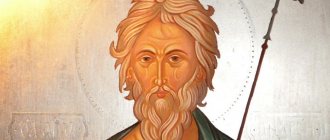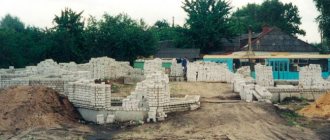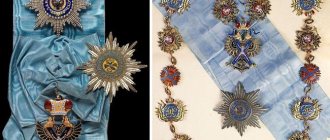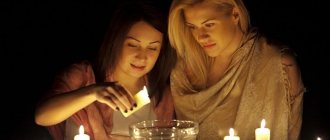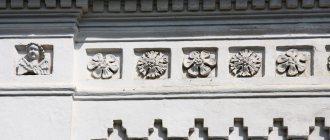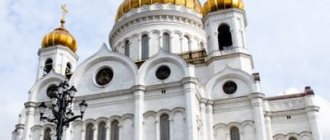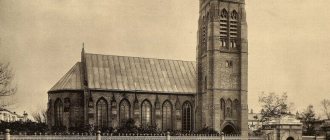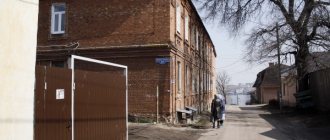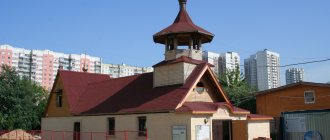The history of the Church of the Apostle Andrew began with the construction of a temple in the name of St. Tikhon.
The history of the Church of the Apostle Andrew begins on April 13, 1999, when His Holiness Patriarch Alexy II of Moscow and All Rus' was still the head of the Russian Orthodox Church (ROC).
April 13, 1999
from this day the Church of the Apostle Andrew begins its history
He arrived in Lyublino, where there was not yet a single church, and consecrated the foundation stone for the throne of the future church in the name of St. Tikhon, Patriarch of All-Russia.
The church was located on the territory of the Orthodox community of Apostle Andrew the First-Called. It was a small wooden church for 120 - 150 people.
Construction of the first church in the temple complex
The first services began in the basement (ground floor) of the temple on January 1, 2000. At this time the temple itself was being built and the parish was growing. Its consecration took place on the bright spring holiday - Annunciation (2001).
The services themselves, in the then wooden church, began on Easter 2003. The temple began to be ennobled and covered with facade stone.
Since 2006, on the territory of the temple complex there has been a children's Orthodox singing gymnasium “Lublino” (9 classes). In addition to the usual school and music education, children also receive spiritual education.
Orthodox singing gymnasium in Lyublino
With the growth of the parish, the question of building a new large cathedral became acute. The Church of the Apostle Andrew the First-Called (designed for 1,500 people) appeared to them.
The construction of the temple was announced on the patronal holiday.
In his speech to the people, Archpriest Viktor Shkaburin said:
“Today we have an unusual patronal holiday. Today we celebrate our anniversary!
Our parish is 20 years old! During this time, we created a strong Orthodox community, a spiritual family.
We organized the education of our children in the Orthodox gymnasium.
And this year we already had our first graduation, and all our students entered the colleges of their choice.
We are 20 years old!
And finally, the time has come to begin the construction of the main capital temple.
All the preparatory work, which is invisible to the eye, has practically been completed. I ask for prayers!”
Victor Shkaburin
archpriest
This is what the Church of the Holy Apostle looks like according to the project
The construction of the Church of the Apostle Andrew was included in the “200 churches” program. This program started in Moscow in 2010. The goal is the construction of Orthodox churches in that part of the city where at the moment they are especially lacking, because existing churches cannot accommodate all parishioners.
Thanks to the “200 temples” program, the Church of St. Andrew the First-Called was built. Website of the 200 temples program
The construction of the Church of the Apostle Andrew was included in the “200 churches” program. This program started in Moscow in 2010. The goal is the construction of Orthodox churches in that part of the city where at the moment they are especially lacking, because existing churches cannot accommodate all parishioners.
The peculiarity of the cathedral is that it is supposed to have only 1 dome. There will be no columns in the temple premises. This is very convenient for parishioners, because... nothing blocks the view and you get more space and better acoustics.
The belfry is adjacent to the facade of the building and they form a vast temple area in front of the main entrance to the temple. The cathedral will be beautiful, white stone, like old Russian times.
The Church of the Apostle Andrew is still under construction, so you can see such an announcement at the entrance
Upon completion of construction, it is planned to delineate the “responsibilities” of the temples.
Regular liturgies and baptisms will take place in the church in the name of St. Tikhon, Patriarch of All-Russia; holiday liturgies and educational activities will move to the new church of St. Andrew the Apostle.
The rector of the temple also talks about plans for a concert hall in the Cathedral of St. Andrew the First-Called, where students of the singing gymnasium will perform, an exhibition hall and a museum (ecclesiastical historical).
The temple is still under construction and no services are held there.
Initially, the building allocated to the gymnasium was intended for domestic needs, so it is small in size and not enough for all students. They plan to expand it with the help of a temple under construction, where the gymnasium will occupy the ground floor.
Previously, there were no churches in Moscow named in honor of St. Andrew the First-Called, although he is the first enlightener of Rus', or rather the land where the predecessors of the Slavs lived. Although in Russia the saint is highly revered (the highest order of Russia is the Order of St. Andrew the First-Called, St. Andrew's Cross is the flag of our fleet).
Temples at the Vagankovskoe cemetery
Central Deanery
November 11, 2018
Parish of the Church of the Resurrection of the Word at the Vagankovskoye Cemetery
Address: 123022, Moscow, Sergeya Makeev Street, 15 El. mail: Temple website: vagankovo.net Phone: , 255-06-22
Church of the Resurrection of the Word at the Vagankovskoye Cemetery
HISTORICAL REFERENCE
The temple was founded in 1819 instead of the dilapidated original wooden church of St. John the Merciful, built in 1773, on the site of which a rotunda chapel was built and remains to this day. The architect Afanasy Grigoriev worked on the project. Construction was carried out at the expense of the Bolotnov merchants and continued for 12 years.
The main altar of the temple was consecrated on September 26, 1831 by Saint Philaret (Drozdov), Metropolitan of Moscow and Kolomna, in honor of the Renewal (consecration) of the Church of the Resurrection of Christ in Jerusalem. This holiday is also popularly called “The Resurrection of the Word” and means that it is “said” or “reputed” to be the Resurrection, in contrast to the Feast of the Bright Resurrection of Christ and refers specifically to the consecration of the temple in honor of the Resurrection of Christ. The altars of the side chapels of the refectory part of the temple were consecrated in 1824 in honor of St. Nicholas, Archbishop of Myra in Lycia, the miracle worker (south), and the martyr Aquilina (northern).
The architectural style of the Church of the Resurrection of the Word is “mature Empire” - the style that completed the era of Russian classicism in architecture. The quadrangle of the temple is crowned with a domed light rotunda with a small silent drum. From the west it is adjoined by a refectory and a high three-tier bell tower. The facades are distinguished by the characteristic restraint of the Empire style in the interpretation of details. The side facades of the aisles are accented with four-column Tuscan porticoes made of white stone. The entrance is decorated with two-column white stone porticoes “in antas”. The order theme is continued in the framing of the windows. The rectangular openings are inscribed in arched niches and flanked by Ionic columns supporting light entablatures. The architectural ensemble of the temple is an object of cultural heritage.
In 1864, the Church of the Resurrection of the Word was expanded by adding two more chapels to the main altar. The northern aisle was consecrated in honor of St. John the Merciful, Patriarch of Alexandria, and the southern aisle in honor of St. Theodore Sikeot, Bishop of Anastasioupolis.
The temple never closed. Even after the 1917 revolution it remained open to believers. In 1922, as part of a program to confiscate church valuables, the Bolsheviks nationalized more than 18 pounds of gold and silver church decorations and utensils. From 1922 to 1944 the temple was in the hands of renovationists. In 1945 the temple was returned to the Moscow Patriarchate.
Currently, the church operates a Sunday school: a children's group and a “discussion club” for adults. The refectory is open for pilgrims. Public conversations are held before the sacraments of Baptism and Marriage.
SACRED TEMPLE
Icons with particles of holy relics: St. Nicholas the Wonderworker, St. John the Merciful (in the altar of the main chapel), St. Luke of Crimea and martyr. Abraham of Bulgaria. Reliquary with particles of the holy relics of the Optina elders. Icon of the Mother of God “Seeking the Lost”, Athonite Icon of the Mother of God “The Tsarina of All”. Sculptural wooden image of the head of the honest, glorious Prophet, Forerunner and Baptist of the Lord John. The revered icon of St. Nicholas in the chapel of St. John the Merciful. Icon of St. Seraphim of Sarov with a piece of mantle (in the altar of the main chapel). Icon of St. Zosima of Vorbozom. Icon of the saint Matrona of Moscow with a piece of the coffin. Icon of the New Martyrs of Vagankovsky Icon with the image of the saints in whose honor the chapels of the Church of the Resurrection of the Word were consecrated. Temple icon of the Renewal (consecration) of the Church of the Resurrection of Christ in Jerusalem. Icon of the Hieromartyr Neophytos (Lyubimov) - rector of the Vagankovsky Church from 1902 to 1914.
WORSHIP
Divine services are held daily. On weekdays and on Saturdays it starts at 8.00, on Sundays - at 9.00 the prayer service with water, at 9.30, at 10.00 the Divine Liturgy. Every day after the Liturgy, a Memorial Service is celebrated (except for days when the remembrance of the dead is not performed according to the Charter). During the period from Dimitrievskaya Parental Saturday to Pentecost, on Sundays there is an early Divine Liturgy at 7.00 in the assigned church of the Apostle Andrew the First-Called. On Parental Saturdays (including small Parental Saturdays during Lent) early Divine Liturgy at 7.00 in the chapel of St. Theodore Sikeota, late Liturgy in the main chapel at 10.00. Sunday all-night vigil on Saturdays at 16.00. On the eve of the days of remembrance of especially revered saints, icons of the Mother of God and great holidays, an All-Night Vigil is celebrated at 17.00. Every Saturday (except for the period of Lent) at 15.30 a prayer service is held before the revered icon of St. Luke of Crimea with a particle of his holy relics. On Sundays (except for Holy Easter and Antipascha) at 12.00 a memorial service is held at the grave of Archpriest Valentin Amfiteatrov (21st section of the Vagankovsky cemetery).
Church of the Apostle Andrew the First-Called (attached to the Church of the Resurrection of the Word at the Vagankovsky cemetery)
Address: 123022, Moscow, Sergeya Makeev street, 15с2
HISTORICAL REFERENCE
In 1824, an almshouse and a parochial school were built at the Vagankovskoye cemetery at the Church of the Resurrection of the Word. Later, in 1916, the school was rebuilt into a temple, which was consecrated that same year in honor of the Holy Apostle Andrew the First-Called. This church is the only church of St. Andrew the First-Called built in Moscow before the revolution.
From 1922, when the main Church of the Resurrection of the Word was captured by renovationists, to 1924-25. St. Andrew's Church became a refuge for the clergy of the Patriarchal Church. By 1925 the temple was closed. At first, the church building housed a dormitory, then various cemetery services. During Soviet times, both wings of the Vagankovsky cemetery were taken under state protection. In the early summer of 1989, it was decided to transfer the building to the Russian Orthodox Church. Restoration work continued for three months and already on October 21, 1989, the temple was consecrated by Archbishop Alexy (Kutepov) of Zaraisk.
SACRED TEMPLE
Icon of St. Alexia, Metropolitan. Moscow, and Apostle Andrew the First-Called with a particle of his St. relics. Icons of the Mother of God: “Tenderness” Yaroslavl, Tikhvin, Smolensk, Feodorovsk, Arabian or Arapetskaya “Oh, All-Singing Mother”. Icon of St. Sergius of Radonezh (built in memory of Sergius Vasilyevich Obidin, who died on September 30, 1889 and was buried at the Vagankovsky cemetery). Icon of St. St. Nicholas the Wonderworker (in the narthex, full-length, was formerly on the outer wall of the St. Nicholas chapel of the Church of the Resurrection of the Word).
WORSHIP
In the Church of the Apostle Andrew the First-Called, early Divine Liturgies are celebrated at 7.00 on Sundays (except for the summer period) and most funeral services throughout the year. On the day of the Apostle Andrew the First-Called, December 13, an All-Night Vigil is held (the day before at 17.00), the Divine Liturgy and the Procession of the Cross.
Church of the Great Martyr George the Victorious and Hieromartyr Valentin the Roman, presbyter (baptismal, assigned to the Church of the Resurrection of the Word at the Vagankovskoe cemetery)
Address: 123022, Moscow, Sergeya Makeev street, 15с2
HISTORICAL REFERENCE
Temple of the Great Martyr. St. George the Victorious and Sschmch. Valentine the Presbyter was built in the historical building of the Sunday school and almshouse at the Church of the Resurrection of the Word. Consecrated in 1991. The rite of consecration was performed by the First Vicar of His Holiness the Patriarch of Moscow and All Rus', Metropolitan Arseny of Istra.
In 2003, a marble baptistery was built in the temple to perform the Sacrament of Baptism for adults by complete immersion.
SACRED TEMPLE
Icon of the Prophet Elijah in an ancient icon case. Icon of the Prophet, Forerunner and Baptist of the Lord John in an ancient icon case.
WORSHIP
The Sacrament of Baptism is performed in the St. George Church. On the days of remembrance of the Great Martyr. St. George the Victorious (May 6) and Sschmch. Valentine the Roman, presbyter (May 19), the All-Night Vigil (the day before at 17.00), the Divine Liturgy and the Procession of the Cross.
CLERGY
Hegumen PETER (Eremeev Ruslan Nikolaevich), rector. Born December 2, 1973. Education: Moscow Theological Academy, candidate of theology; Sofia State University, Doctor of Theology. December 6, 1998 ordained hieromonk. On June 13, 2013, he was appointed rector and chairman of the Parish Council of the Church of the Resurrection of the Word at the Vagankovskoye cemetery.
Archpriest Mikhail Vyacheslavovich MELNIKOV. Born March 6, 1961 Education: Moscow Theological Seminary. On February 12, 1985, he was ordained to the rank of deacon. On December 25, 1989, he was ordained to the rank of priest.
Archpriest Sergiy Vasilievich SECRIY. Born June 6, 1978. Education: Moscow Theological Academy, candidate of theology. On January 18, 2003, he was ordained to the rank of deacon. On June 16, 2003, he was ordained to the rank of priest.
Priest Sergiy Ivanovich MATYUSHIN. Born March 4, 1974. Education: Moscow Theological Academy, candidate of theology. On January 18, 2000, he was ordained to the rank of deacon. On July 21, 2005, he was ordained to the rank of priest.
Deacon German Vasilyevich DEMIDOV. Born September 25, 1973. Education: Moscow Theological Academy, candidate of theology. On March 15, 2013, he was ordained to the rank of deacon.
Deacon Vladimir Sergeevich PRAVDOLYUBOV. Born March 9, 1983. Education: Orthodox St. Tikhon's University for the Humanities, Master of Theology. On October 9, 2011, he was ordained to the rank of deacon.
DRIVING DIRECTIONS
Directions to the station metro station "Ulitsa 1905 Goda", the first car from the center, then along the street. Bolshaya Dekabrskaya to the intersection with the street. Sergei Makeev, passage through the main entrance to the territory of the Vagankovsky cemetery.
Schedule of services in the temple complex
The schedule of services is posted on the official website of the temple.
Temple complex of St. Andrew the First-Called Apostle Official website
The schedule is updated monthly. In addition to the Liturgy, conversations are held in the church.
- Conversation with the rector;
On Saturdays, at the end of the evening service (at about 19.00), the rector of the church, Father Victor, answers questions from parishioners.
- Gospel Conversations;
On Thursdays after the evening service at 7:30 p.m., Priest John Koval gives talks about Faith and the life of the Church.
- Conversations about holy ascetics;
On Fridays, at the end of the evening service (at about 18.30), conversations are held about the history of the Church, the life of the Holy Ascetics of Piety. Conducted by Alexander Evgenievich Chermensky
- Public conversations.
In our church, public conversations are held for adults and children over 12 years of age who consciously wish to be baptized, as well as for parents of baptized children and those who want to become godparents.
Conversations are held in the church every Saturday at 15:00. Without public conversations, the sacrament of baptism cannot be performed (except in the event of a fatal illness of the person wishing to be baptized).
